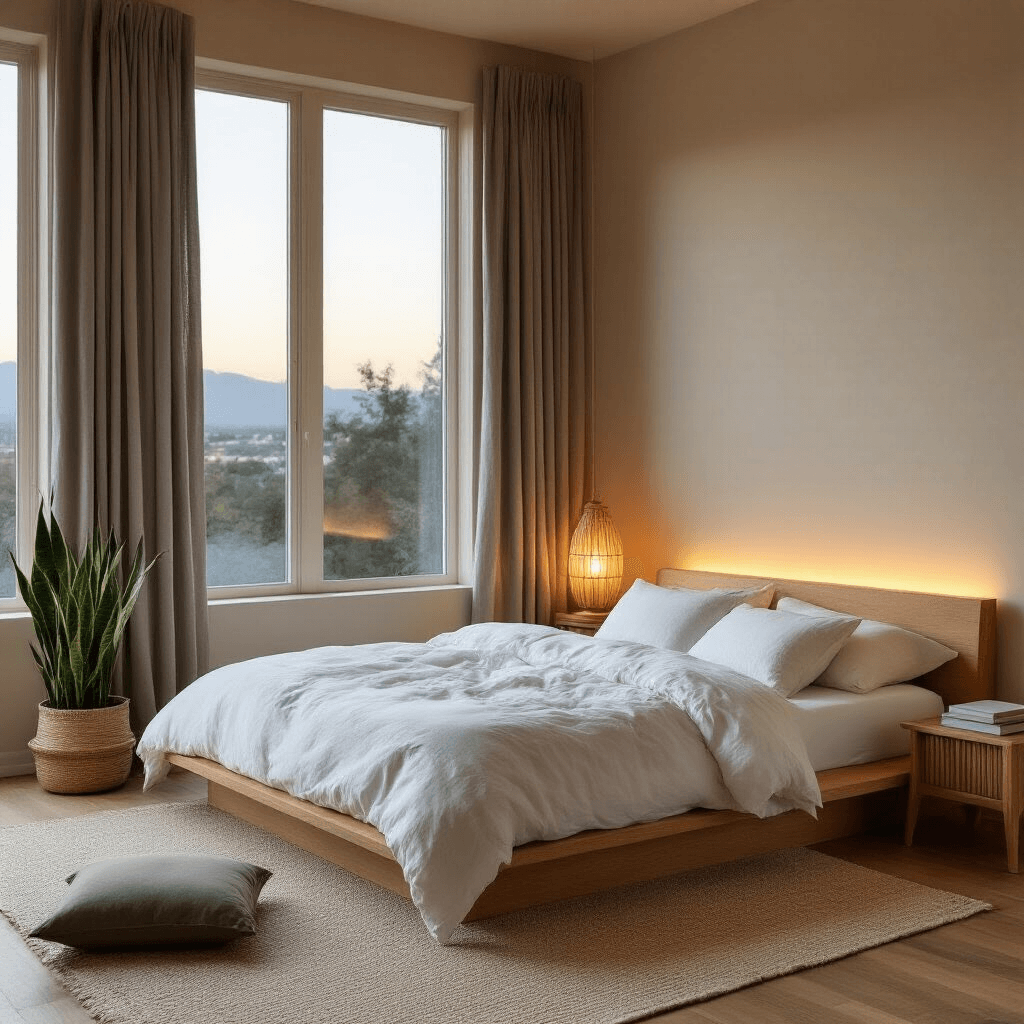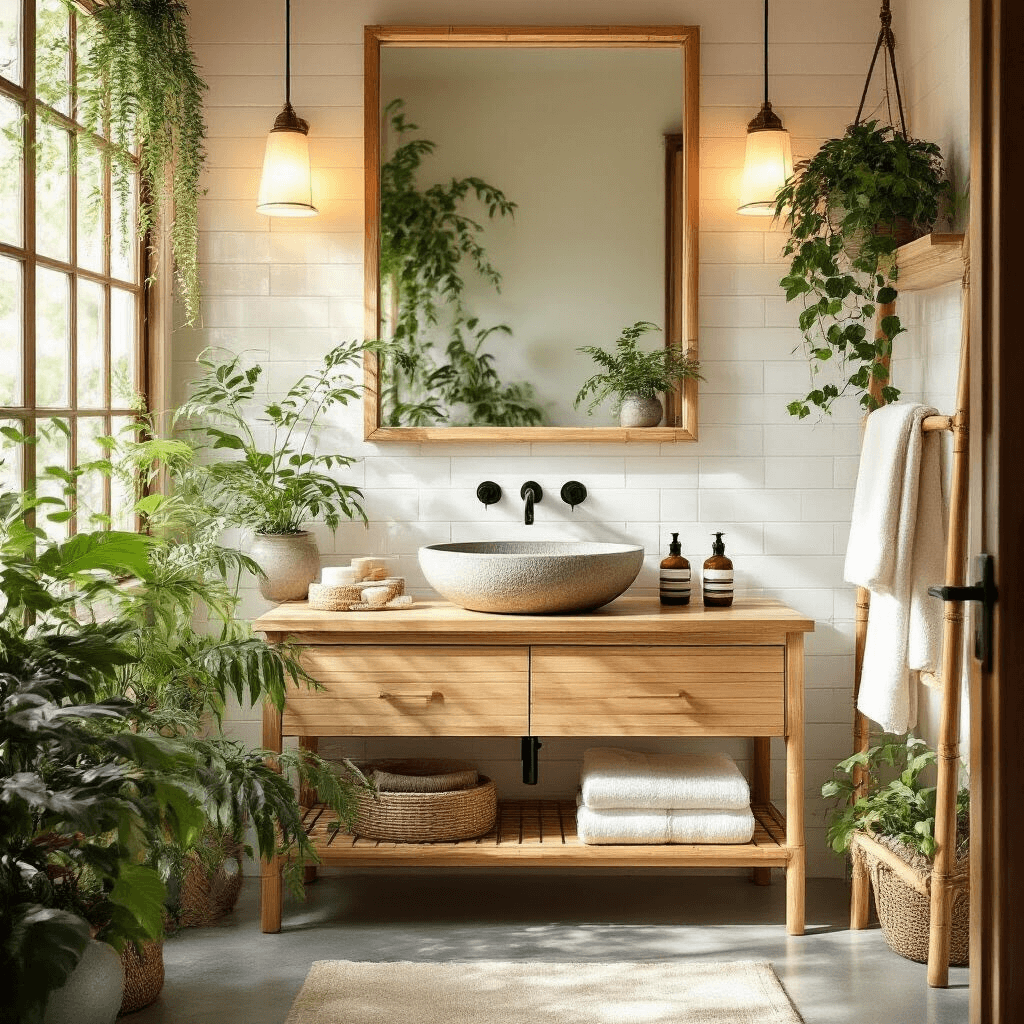This post may contain affiliate links. Please see my disclosure policy for details.
Creating Your Zen Home: Transform Your Space Into a Peaceful Sanctuary
Contents
- Creating Your Zen Home: Transform Your Space Into a Peaceful Sanctuary
- Why Your Current Decor Might Be Working Against You
- The Foundation: Natural Colors That Ground Your Space
- Furniture That Embraces Simplicity Without Sacrificing Comfort
- Textures That Connect You to Nature
- The Art of Strategic Decluttering
- Bringing Nature Indoors: Plants and Natural Elements
- Lighting That Supports Natural Rhythms
- Room-by-Room Zen Transformation
- Living Room: Your Daily Retreat
- Bedroom: Sacred Sleep Space
Zen home decor starts with a single question: when was the last time you walked into your living room and actually felt peaceful?
I get it. Your home should be your refuge, but instead, it feels chaotic, cramped, or just plain stressful. Between work demands and daily life, our spaces often become dumping grounds rather than sanctuaries.
After years of experimenting with different design approaches, I’ve discovered that zen-inspired decor isn’t about turning your home into a monastery. It’s about creating intentional spaces that actually help you breathe easier and think clearer.
Why Your Current Decor Might Be Working Against You
Most of us have accumulated too much stuff without realizing it.
Every surface gets covered. Every wall gets filled. Every corner gets claimed.
The result? Visual noise that keeps your brain from ever truly relaxing.
Zen design flips this approach completely. Instead of adding more, we start removing what doesn’t serve us.
The Foundation: Natural Colors That Ground Your Space
Your color palette sets the emotional tone for everything else.
I learned this the hard way after painting my first apartment in bold, energetic colors that made me feel wired instead of relaxed.
Start with these calming base colors:
- Warm whites and creams for walls and larger pieces
- Soft beiges and taupes for grounding elements
- Muted greens or grays as gentle accents
- Natural wood tones to bring warmth
These colors work because they mimic what we see in nature – think sandy beaches, smooth river stones, and morning mist.
Avoid bright, saturated colors in large doses. They create energy when you’re trying to cultivate calm.
Furniture That Embraces Simplicity Without Sacrificing Comfort
Zen furniture follows one simple rule: clean lines with natural materials.
But here’s where many people get it wrong – they think minimal means uncomfortable.
Look for pieces that balance function and tranquility:
- Low-profile seating that keeps sight lines open
- Platform beds that create a floating effect
- Natural wood or bamboo construction whenever possible
- Built-in storage to hide everyday clutter
I replaced my bulky sectional with a low profile wooden sofa and immediately noticed how much more spacious the room felt.
The key is choosing fewer, higher-quality pieces rather than filling every corner with furniture.
Textures That Connect You to Nature
This is where zen decor gets really interesting.
While the visual elements stay minimal, you can layer in rich textures that invite touch and create warmth.
Incorporate these organic materials:
- Linen curtains that filter light softly
- Woven jute or bamboo rugs underfoot
- Stone or ceramic accessories for weight and grounding
- Rattan baskets for stylish storage
I added a natural fiber area rug to my bedroom and was amazed at how it transformed the space from stark to inviting.
The contrast between smooth and textured surfaces creates visual interest without clutter.
The Art of Strategic Decluttering
Here’s what nobody tells you about zen spaces: the empty areas are just as important as the filled ones.
Negative space gives your eyes places to rest and your mind permission to quiet down.
My decluttering approach:
- Remove anything that doesn’t serve a purpose or bring joy
- Clear all surfaces except for 1-2 intentional items
- Create pathways that flow naturally through rooms
- Use closed storage to hide necessary but visually messy items
Start with one room and be ruthless. I promise you won’t miss most of what you remove.
Bringing Nature Indoors: Plants and Natural Elements
Nothing transforms a space quite like living plants.
They purify air, add gentle movement, and create that crucial connection to the natural world.
Best zen-friendly plants:
- Peace lilies for low-light corners
- Snake plants for bedrooms (they produce oxygen at night)
- Bamboo for bathroom humidity
- Small bonsai for tabletops and meditation areas
Don’t go overboard – three to five plants per room is plenty.
I also love incorporating small tabletop fountains for the gentle sound of moving water.
Lighting That Supports Natural Rhythms
Harsh overhead lighting kills the zen vibe instantly.
Think about how you feel under fluorescent office lights versus sitting by a campfire. Your home lighting should lean toward the campfire end of that spectrum.
Layer your lighting thoughtfully:
- Maximize natural light during the day with sheer curtains
- Use warm-toned LED bulbs (2700K-3000K color temperature)
- Add floor lamps and table lamps for evening ambiance
- Include candles for ultimate relaxation
I installed dimmer switches throughout my home and now adjust the lighting based on time of day and mood.
Room-by-Room Zen Transformation
Living Room: Your Daily Retreat
This is where most of us spend our relaxation time, so getting it right matters.
Essential elements:
- Low, comfortable seating arranged for conversation
- One statement piece of nature-inspired art
- Hidden storage for remotes, magazines, and daily items
- Several plants at different heights
- Soft throw blankets for texture and warmth
Keep the coffee table clear except for perhaps a small plant or single decorative bowl.
Bedroom: Sacred Sleep Space
Your bedroom should feel like a cocoon – completely separate from the outside world’s demands.
Zen bedroom basics:
- Platform bed with natural fiber bedding
- Blackout curtains or shades for










